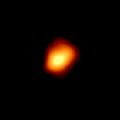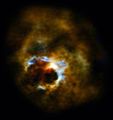Red giant facts for kids
A red giant is a very large giant star. It gets its name because it looks red and is huge. These stars are much bigger than our own Sun. They can be from half the Sun's mass up to ten times its mass. Imagine fitting thousands of Suns inside one red giant! Famous red giants include Aldebaran, Arcturus, Betelgeuse, and Mira.
Right now, our Sun is a main-sequence star. This means it is in the main part of its life. But in about five billion years, scientists think our Sun will become a red giant. It will grow to be about 200 times wider than it is today. When this happens, it will become so big that it might swallow Mercury, Venus, and maybe even the Earth.
How a Star Becomes a Red Giant
All new stars create energy by changing hydrogen into helium. This process is called nuclear fusion. It makes a lot of energy, like light and heat. In a normal star, such as our Sun, this fusion happens in the very center.
Over a long time, most of the hydrogen in the star's center turns into helium. When this happens, the nuclear reaction slows down. The star's center then starts to shrink because of the star's own gravity. This shrinking makes the layer of hydrogen just outside the center get much hotter. This hotter hydrogen then starts to fuse into helium.
With this new energy source, the outer layers of the star expand a lot. The star becomes much brighter, sometimes thousands of times brighter. Because the outside of the star is now so much bigger, the energy spreads out. This makes the star's surface temperature drop, and its color changes to red or orange.
The red giant phase does not last forever. It is much shorter than the billions of years a star spends as a main-sequence star. After a few hundred million years, red giants start to fuse helium into other elements. These can include carbon, nitrogen, and oxygen. Some of their outer layers will drift away into space. This leaves behind gas and dust circling the star. Most red giants will eventually become white dwarfs. However, very large red giants can turn into neutron stars or even black holes.
Related Pages
Images for kids
-
Mira, a variable asymptotic giant branch red giant
-
Mira A is an old star, already shedding its outer layers into space
See also
 In Spanish: Gigante roja para niños
In Spanish: Gigante roja para niños





